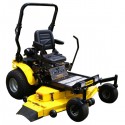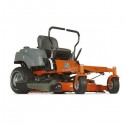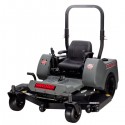Best Zero Turn Mower
These are the 8 best zero turn mowers based on product quality, customer satisfaction, and price:
 Keeping your lawn looking well manicured is no easy task.
Keeping your lawn looking well manicured is no easy task.
You have to make sure it is properly sodded and seeded; keeping weeds and crab grass at bay is no easy task; and when dry spells hit, you have to make sure you are watering it enough so it doesn’t dry out and get brown patches. But the task you will have to do so frequently to keep you lawn looking beautiful is mowing it.
When you have a big lawn, this can be a lot of work in and of itself. You want a lawn mower that will get the job done as quickly and efficiently as possible. Because there are so many options out there, it can be difficult to decide which kind is right for you. But if you have a lawn that is more than a half an acre or even larger, there is really only one machine that is right for the job.
Zero turn mowers are the biggest, baddest, and most powerful grass cutting machines on the market today. There are models that are designed for residential use, and these are perfect for homeowners with more than a half an acre of lawn that needs taking care of. Zero turn mowers have the widest cutting decks, the most cutting blades, and the biggest, most powerful engines of any lawn mower out there. With one of these on your side, you will be able to tackle any size lawn, even those with the toughest varieties of grass and densest plantings, quickly and efficiently.
There are commercial zero turn mowers that are designed for lawn care companies so they can tackle half a dozen or more properties in a single day. These huge machines can cut the average suburban lawn in a matter of minutes and have the landscaping crew on to the next job quickly. And there are mid-range zero turn mowers that are designed for keeping athletic fields or institutional lawns looking great. Which class is best for you obviously depends on what you intend to use it for.
At that point, finding the right mower can still be a challenge. There are so many different models out there, and each one claims to be the best. But there are a number of important criteria that, once you understand them, can help you figure out which kind of zero turn mower is best for your needs. Whether you are looking for a zero turn mower to keep your own property looking beautiful or shopping for a new piece of equipment to add to your landscaping company’s fleet, by applying these criteria you can quickly determine if a particular model has the specifications you need.
This way, you can narrow down the astonishingly wide range of zero turn mowers to just a few different ones. At that point, you will know what to look for in terms of what is under the hood, what criteria are important concerning the deck, and which design and manufacturing features indicate real quality in a mower.
1. Best Zero Turn Mower Characteristics
1a. Deck Size
 The whole reason to buy a zero turn mower is so that you can have the kind of extra wide cutting deck that will allow you to tackle big areas quickly and efficiently. An extra large cutting deck can cut down on the amount of time it takes to finish a job by as much as half an hour or more. When you are investing in a zero turn mower, there is no point purchasing a model that does not take full advantage of the intended design of these machines to pack as much cutting width into the deck as possible.
The whole reason to buy a zero turn mower is so that you can have the kind of extra wide cutting deck that will allow you to tackle big areas quickly and efficiently. An extra large cutting deck can cut down on the amount of time it takes to finish a job by as much as half an hour or more. When you are investing in a zero turn mower, there is no point purchasing a model that does not take full advantage of the intended design of these machines to pack as much cutting width into the deck as possible.
Cutting decks on zero turn mowers range from about 40 inches to 56 inches or more. Those extra sixteen inches may not seem very significant, but trust me: they can mean a world of difference. They add up quickly from one pass to the next, and after just three passes you have already cut down on the time you’ve spent cutting that section of the lawn by more than 25%. While the deck size is not the only important characteristic for finding the right zero turn mower, in my opinion it is probably the most important one.
And as a general rule of thumb it is always advisable to go for the zero turn mower with the wider deck size, all else being equal. You may wind up spending a bit more on a model with a bigger deck, but the amount of time and work it will save you in the long run is well worth it. When you are already spending the kind of money a quality machine costs, the extra little bit for a bigger deck is not that much to spend for the return you are getting.
The cutting power of the deck is not just determined by its width alone. Extra wide cutting decks on zero turn mowers need multiple blades to support that kind of width, and not all models are created equal in this regard, either. Some zero turn mowers will try to support extra wide cutting decks with just two blades, but it is always better to find a model with at least three. The additional blade makes the cutting deck much more efficient. It ensures that fewer individual stalks of grass get missed on the first pass. And it cuts down significantly on how often the blades will need to be sharpened to keep them running well.
1b. Engine
 A zero turn mower with a big, powerful cutting deck is going to need a top of the line engine to support it. Engines in these machines have considerable differences from one to the next, and it is important to ensure you are getting a machine with the kind of high performance engine under the hood that will provide reliable power over the long term. One way to quickly get a good sense of whether a zero turn mower has a quality engine under the hood is to check the manufacturer. Some of the best names in small engine fabrication are Briggs & Stratton, Kohler, Kawasaki and Honda. These are trusted manufacturers who consistently design and build high quality engines that push the envelope in terms of packing a lot of power into a small space.
A zero turn mower with a big, powerful cutting deck is going to need a top of the line engine to support it. Engines in these machines have considerable differences from one to the next, and it is important to ensure you are getting a machine with the kind of high performance engine under the hood that will provide reliable power over the long term. One way to quickly get a good sense of whether a zero turn mower has a quality engine under the hood is to check the manufacturer. Some of the best names in small engine fabrication are Briggs & Stratton, Kohler, Kawasaki and Honda. These are trusted manufacturers who consistently design and build high quality engines that push the envelope in terms of packing a lot of power into a small space.
But you can’t always just shop based on brand names. Sometimes a zero turn mower will have an engine that was made in-house specifically for that machine, and sometimes two mowers made by different manufacturers will have engines made by the same outside company. When that is the case, it is always good to be familiar enough with how engines work to get a quick sense of which one is able to deliver superior power.
There are a few design specs that you can learn to look at to quickly asses the power and quality of a particular engine. The horsepower, displacement, and torque determine the overall power of an engine. Horsepower is a fairly well known indicator of an engine’s total power. On zero turn mowers, an HP of about 23 or more is reasonable. The displacement, measured in cubic centimeters, indicates how much volume the pistons in the engine sweep during a single cycle. As displacement goes up, so does the amount of power the engine puts out. Torque is an indicator of the rotational force the engine produces, and it is measured in foot-pounds.
By looking at all three of these specs, you can get a pretty good sense of how powerful one engine is compared to another. The remaining features of an engine that are important are its fuel efficiency and CARB compliance. Higher fuel efficiency is better because it means you will have to buy less gas for your mower. CARB compliance determines whether the engine meets California’s emissions standards. If it doesn’t there are a number of states – including California – where you can’t buy the mower.
1c. Materials & Design
 When you are looking for new zero turn riding mower, you are probably not going to be using it to cut grass on a small, even, and thinly planted lawn, right? Of course not. These machines are designed to tackle big jobs, cut through tough, dense grasses, and handle uneven, difficult terrain without breaking a sweat. You are not looking for a small, weak mower here that is only meant to be used one a month and treated delicately. You want a big guy that you can count on to hold up under pressure. That is why considerations about its materials and design are so important.
When you are looking for new zero turn riding mower, you are probably not going to be using it to cut grass on a small, even, and thinly planted lawn, right? Of course not. These machines are designed to tackle big jobs, cut through tough, dense grasses, and handle uneven, difficult terrain without breaking a sweat. You are not looking for a small, weak mower here that is only meant to be used one a month and treated delicately. You want a big guy that you can count on to hold up under pressure. That is why considerations about its materials and design are so important.
There are several areas to look at when you are considering a zero turn mower where it’s important to make sure the materials and design are durable and well made. First off, you want to make sure the blades on the mower are made from high-quality, hardened steel. This is especially important if you are going to be using your zero turn mower on tougher varieties of grass like Bermuda or St. Augustine. You do not want your blades to be made of the kind of materials that will be worn down quickly and need constant sharpening. Sharpening the blades on a zero turn mower is a time consuming process.
The deck, front casters, and body of the zero turn mower should also be made of durable, tough materials. I have yet to see a zero turn mower that has a body or casters that is not made out of steel, but not all steel decks are the same. There are two options for manufacturing components out of steel: they can be welded or stamped. Stamped steel, while quite durable in its own right, is not quite the same as welded steel. Stamping – also known as pressing – uses a machine press to form the steel components of the mower. Welding is a fabrication process that results in much tougher seams and an overall higher quality of all the components involved.
Zero turn mowers with welded steel frames and decks are often a bit more expensive than those with stamped components, but there is a good reason for this. Mowers with welded components are going to be much tougher over the long term than those with stamped parts. They will need fewer repairs and hold up to wear and tear much better, which means their overall lifespan will be much longer.
1d. Controls & Accessories
 A zero turn mower is a big, powerful machine, and because of that it is important to make sure you are using it safely. Steering a zero turn mower can be done one of three ways. The most common method uses a variable hydrostatic drive, in which two levers control the speed of each of the two rear wheels independently. This system can take some getting used to, especially when turning the mower, but it is efficient. Pushing both levers forward at the same time causes the mower to move in a straight line. Pushing one lever farther forward than the other will cause it to turn in the opposite direction. And pushing one lever forward while holding the other all the way back causes the mower to spin on its axis (hence the term “zero turn”).
A zero turn mower is a big, powerful machine, and because of that it is important to make sure you are using it safely. Steering a zero turn mower can be done one of three ways. The most common method uses a variable hydrostatic drive, in which two levers control the speed of each of the two rear wheels independently. This system can take some getting used to, especially when turning the mower, but it is efficient. Pushing both levers forward at the same time causes the mower to move in a straight line. Pushing one lever farther forward than the other will cause it to turn in the opposite direction. And pushing one lever forward while holding the other all the way back causes the mower to spin on its axis (hence the term “zero turn”).
While this is the traditional method of controlling a zero turn mower, other styles have become popular in recent years. Some models use a steering wheel like the kind you would find in a car, which is much more intuitive, since the mower moves in the direction you turn the steering wheel. And models with joystick controls are becoming increasingly common. Joystick controls have the advantage that you only need one hand to operate the zero turn mower, freeing your other hand for what’s in the cup holder or to move low-hanging branches out of your way.
Speaking of the cup holder, the accessories on a zero turn mower are another important thing to look at when you are comparing one model to the next. Once you have narrowed down your selection to a few mowers with similar cutting deck widths, engines, and manufacturing components, the little differences are what will make one mower outshine the others. Small details like a cup holder or a cockpit chair with lumbar support will make a lot of difference in terms of how easy and enjoyable the overall mowing experience is.
In addition to convenience, safety features are a very important concern. Because of how powerful these machines are, accidents can be very dangerous, and you want a mower that has features in place to protect you. A roll bar is a great feature to protect against the worst accidents, and a seat belt is pretty much a must in my book. Make sure you are getting a machine that protects you while you are using it.
1e. Other Considerations
 There are a number of other considerations that do not fit neatly into any other category, but each of them definitely affects the overall performance and convenience of use in a zero turn mower, and they are important to pay attention to as well. Different zero turn mowers will approach these considerations in different ways, and you want to make sure you are getting one that provides the best all around experience.
There are a number of other considerations that do not fit neatly into any other category, but each of them definitely affects the overall performance and convenience of use in a zero turn mower, and they are important to pay attention to as well. Different zero turn mowers will approach these considerations in different ways, and you want to make sure you are getting one that provides the best all around experience.
There are three potential grass clippings management options on zero turn mowers, and in my opinion it is best to find a machine that offers all three. The most basic one is where the clippings are blown out the side of the cutting deck. For a lot of lawns, this will be just fine; the clippings will be in more or less neat rows, where they will be bleached by the sun and break down into the lawn. Even better than this is a design in which the cutting deck mulches grass clippings into tiny pieces before leaving them on the lawn. These clippings will break down much faster into the lawn, where they will release their stored nutrients into the soil. Finally, some zero turn mowers have detachable bags and bins for collecting grass clippings for later disposal or composting.
The overall weight and size of the zero turn mower is another important consideration. While these machines are large and heavy by their nature – it takes a lot of weight to support a big cutting deck, after all – some are needlessly big or heavy. If you are buying a zero turn mower for residential use, make sure it is going to fit in your garage, and if you have a commercial operation, you want a machine that will fit in your truck bed or trailer. It’s also important to make sure the mower is not so much wider than the cutting deck that you will have a lot of overlap or leave wide areas next to fences or walls that are uncut.
Finally, a word about deck design. It’s important to make sure your zero turn mower has a deck that evenly cuts grass blades on the first pass. For this, a wide, deep deck is best. This kind of deck will have sufficient air circulation to prevent grass from just being blown flat as the mower passes over them. Some companies have fancy terms for this like “air induction technology,” but it basically means the deck is deep enough that air circulates through it well.
2. Best Zero Turn Mower Reviews
Husqvarna RZ3016 




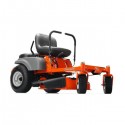
The Husqvarna RZ3016 has a lot of really great features that make it an ideal zero turn mower for use on a residential property that has more than 1/2 acre but less than a full acre of grass to cut. The fact that it is a zero turn mower means that it will be one [...]
Stanley 54ZS 




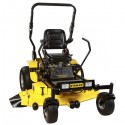
The Stanley 54ZS is a gas powered commercial grade zero turn mower with a Kawasaki FR691V series, 726 cubic centimeter engine that delivers a full 24 HP. The engine is cooled with forced air and has a 90 degree V-twin, four cylinder design and pressurized lubrication for more efficient performance. It has electronic spark ignition [...]
Swisher ZT2760B 




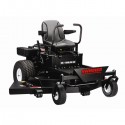
The Swisher ZT2760B has the kind of maneuverability that zero turn mowers are famous for. It has a Dual Eaton manufactured hydrostatic transmission that is designed to provide high quality performance for the best possible maneuverability. This mower can turn on its central axis 360 degrees without stopping or slowing down, which means it will [...]
Husqvarna RZ4621 




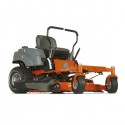
The Husqvarna RZ4621 has lots of great aspects to it that make it a great machine for residential use on a property that has an acre or more of grass that needs cutting. First off, because it is a zero turn mower, it has better maneuverability than any other grass cutting machine out there. Zero [...]
Swisher ZT2452A 




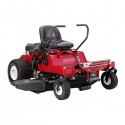
The Swisher ZT2452A is a zero turn riding mower with a Briggs & Stratton Extended Life System V-twin engine with an electric starter. The engine is manufactured by one of the leading manufacturers in the industry, so you can be certain it will provide the kind of power needed to keep this machine working well [...]
These are the 8 best zero turn mowers based on product quality, customer satisfaction, and price:

